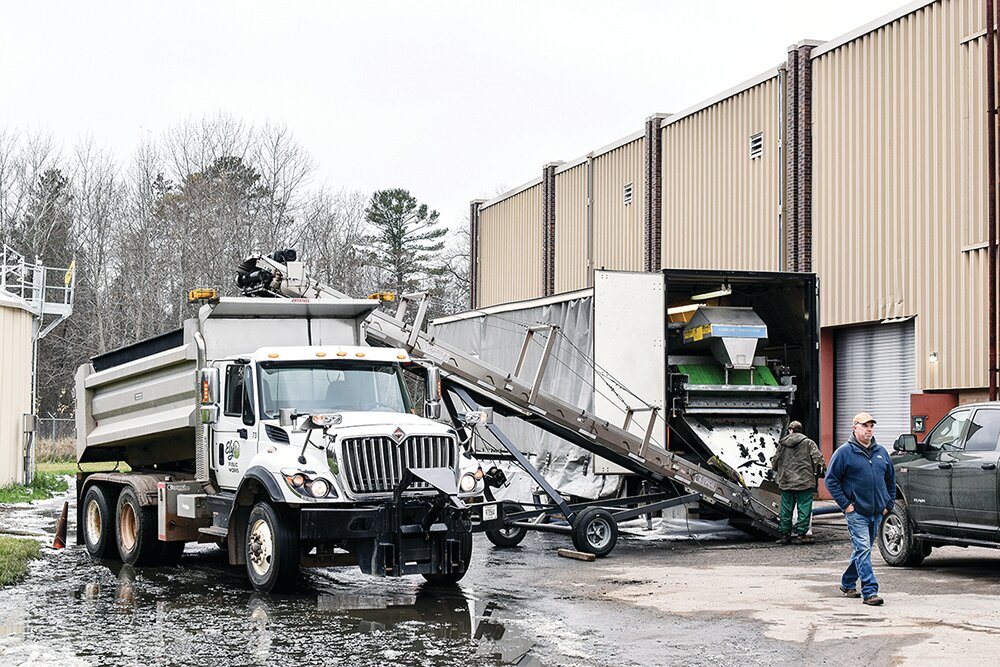Support the Timberjay by making a donation.
Ely squeezes sludge to squeeze a buck
ELY- There is nothing sexy or eye-catching about equipment designed to dewater sewage sludge, but the test last week of dewatering equipment here left the city’s clerk-treasurer, Harold …
This item is available in full to subscribers.
Attention subscribers
To continue reading, you will need to either log in to your subscriber account, below, or purchase a new subscription.
Please log in to continue |
Ely squeezes sludge to squeeze a buck
ELY- There is nothing sexy or eye-catching about equipment designed to dewater sewage sludge, but the test last week of dewatering equipment here left the city’s clerk-treasurer, Harold Langowski, with a big smile on his face.
“It will pay for itself,” Langowski told the Timberjay, referring to the Komline-Sanderson belt press the city rented from Fergus Power Pump of Fergus Falls. Langowski’s preliminary estimate is that the belt press reduced every gallon of biosolids to one-sixth of that volume.
While discussing the project, Langowski also had some strong words about wording. “It’s not sludge,” he stated emphatically, more than once. “It’s biosolids, not sludge.”
The big deal
Why this is a big deal takes a little explaining. Ely’s WWTF separates the influent from its sewers into two final products: biosolids and water. The water discharges to Shagawa Lake but the sludge-like biosolids must go elsewhere.
Ely’s biosolids currently land in a large external tank. According to Langowski, the material delivered to the tank is approximately 3 to 5 percent solid and the rest is water. Large tanker trucks must empty the tank of this biosolids slurry before it fills up. Ely currently disposes of its biosolids by spreading them on fields as fertilizer.
“We send it off to fields … in Embarrass, Waasa Township, and some farms west of Cook,” Langowski explained. The city must pay for the tanker trucks and their transportation costs to ship the slurry to the farmers’ fields. Ely faces an additional problem because fewer farmers are open to using biosolids because of backlash from residential neighbors.
Even after thickening and filtering, the biosolids currently produced by Ely’s WWTF are mostly water. Any reduction in water content will reduce the biosolids weight and volume, which means fewer trucks are needed to haul the material. Because the material processed by the belt press is more like a damp soil, it can be shipped as a solid using smaller dump trucks instead of large tankers. Because it is more solid than not, it can be sent to a sanitary landfill instead of to fields between 30 to 50 miles away. The nearest sanitary landfill which will accept the material is in Virginia, according to Langowski, a distance of 50 miles.
The results of the dewatering test are jaw-droppers: over four days last week, the belt press filled 12 tandem-axle dump trucks with material that would usually occupy seventy tanker trucks. If Ely acquired its own belt press or rented one regularly, the savings in transportation costs would be dramatic.
Cost estimates
Langowski has not yet worked out the least expensive path for Ely to adopt a belt press into its waste processing, whether that may be buying, leasing, renting or sharing the rental cooperatively, which is what Ely did to rent the unit for the test.
“Every year, Mt. Iron, Eveleth and Gilbert get together and share the rental of one of these units,” said Langowski. “We got onto their rental this year.” Ely’s estimated cost for the rental for the test should be between $12,000 and $15,000.
To get an idea of the potential cost savings, the Timberjay estimated the savings on diesel fuel. We used the federal minimum fuel economy of 7.2 miles per gallon for large trucks manufactured after 2014 and the current national average of $4.50 per gallon for diesel fuel.
The round-trip fuel cost of 70 tanker trucks of biosolids to a field 30 miles away in Waasa was $2,625. Sending those trucks 46 miles to Cook raises the cost to $4,375. The cost of sending 12 dump trucks of dewatered biosolids 50 miles to the landfill in Virginia was $750, 3.5 to 5.8 times less than tanker trucks traveling 30 to 50 miles respectively.
We also looked at labor costs, assuming 50 mph highway speeds and $30/hour labor cost. The cost of drivers for the biosolids was $4,200 to $2,520. The 12 trips to the landfill for the biosolids dewatered by the belt press had a labor cost of $720, again 3.5 to 5.8 times less. These are just simple comparisons but they do verify Langowski’s statement that the belt press can deliver significant cost savings on transportation.
Langowski will present his final analysis of the potential cost savings at an Ely City Council meeting in the near future.






